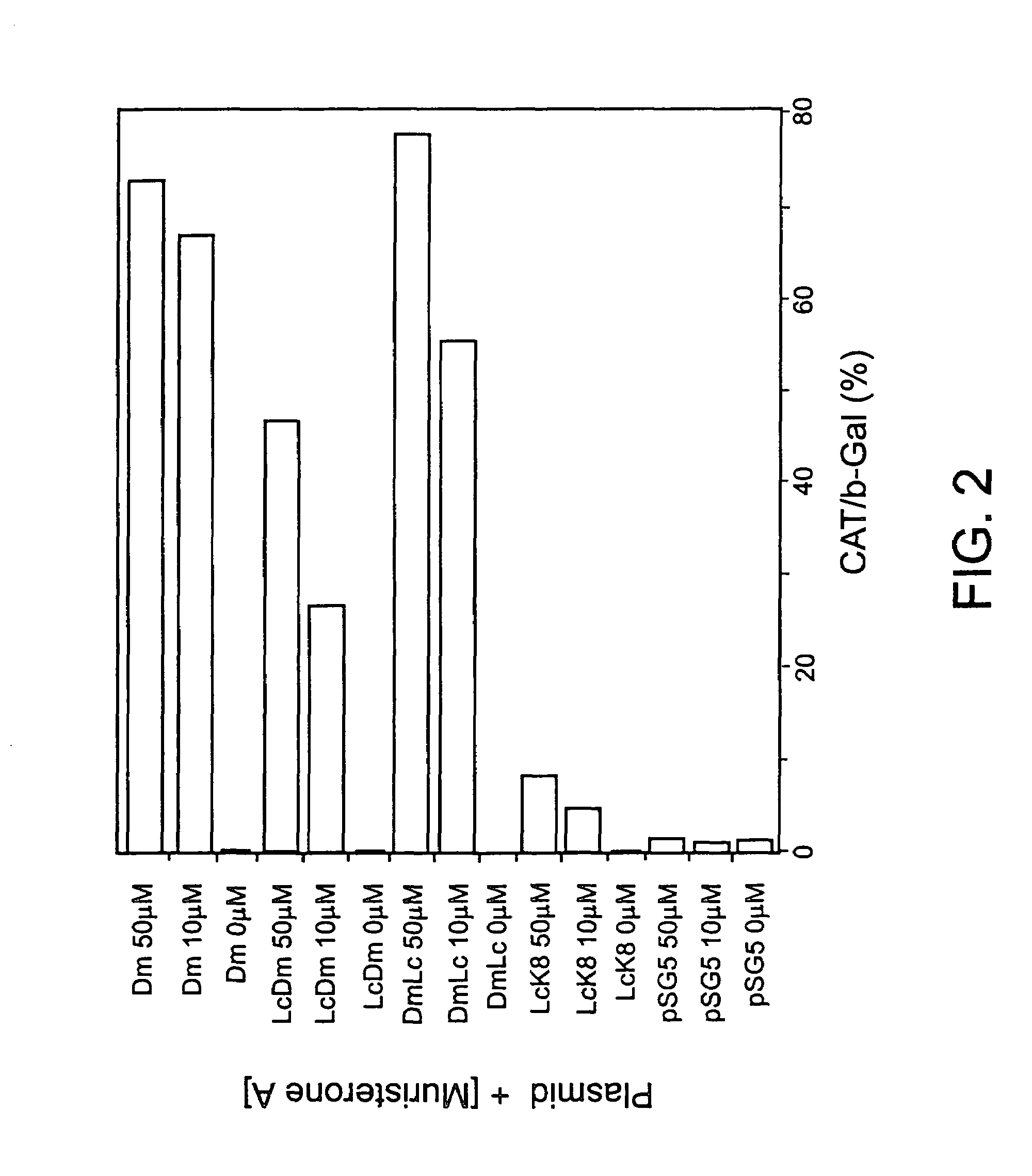Genetic sequences encoding steroid and juvenile hormone receptor polypeptides and insecticidal modalities therefor
a technology of steroid and juvenile hormone, applied in the field of genetic sequences encoding receptor polypeptides and insecticidal modalities therefor, can solve the problems that the d. melanogaster /i>steroid receptor is also of limited utility, and achieve the effects of enhancing the thermostability of said steroid response elements, enhancing the affinity of insect steroids, and enhancing the affinity of insect steroid response elements
- Summary
- Abstract
- Description
- Claims
- Application Information
AI Technical Summary
Benefits of technology
Problems solved by technology
Method used
Image
Examples
example 1
Construction of a Plasmid (pSV40-EcR) Expressing the EcR Polypeptide Subunit of the D. melanogaster Ecdysone Receptor
[0259]A 3110 base-pair Fsp1-HindIII fragment was excised from a cDNA encoding the EcR polypeptide subunit of the D. melanogaster ecdysone receptor (Koelle et al., 1991), the excised sequence comprising the complete 2634 base pair coding region and 214 base pairs of 5′-leader sequence and 258 base pairs of 3′-untranslated sequence. The fragment was ligated into the BamH1 site of the expression plasmid pSG5 (Greene et al, 1988) to produce the expression plasmid pSV40-EcR, wherein expression of the EcR polypeptide subunit of the Drosophila melanogaster ecdysone receptor is placed operably under the control of the SV40 promoter sequence.
example 2
Construction of the Reporter Plasmid p(EcRE)7-CAT
[0260]The reporter plasmid p(EcRE)7-CAT was constructed by insertion of seven copies of the hsp27 ecdysone response element, containing a central 13 base pair palindromic ecdysone response element (EcRE), derived from the hsp27 gene (Riddihough and Pelham, 1987) into the HindIII site of the plasmid pMMTV-CAT (Hollenberg and Evans, 1988), 93 base pairs upstream of the transcription start site of the MMTV promoter, thereby operably connecting expression of the chloramphenicol acetyltransferase structural gene to regulation by an insect receptor which binds to the hsp27 ecdysone response element.
example 3
Cell Culture and Transient Transfection
[0261]Chinese hamster ovary (CHO) cells were maintained in 50% (v / v) Dubbecco's modified Eagle's medium (DMEM) and 50% (v / v) Hamm F12 nutrient mixture (GIBCO) supplemented with 10% (v / v) foetal bovine serum. Transfection was carried out by the DNA-calcium phosphate co-precipitation method (Ausubel et al, 1992). One day before transfection with the plasmids described in Examples 1 and / or 2, or other expression plasmids, CHO cells were plated out at 5-8×105 cells per 6 cm diameter culture dish in the above DMEM / F12 medium. Three hours before the addition of the DNA-calcium phosphate co-precipitate, the cells were washed with phosphate buffered saline (PBS; Sambrook et al., 1989) and cultured in fresh DMEM plus 10% (v / v) foetal bovine serum. The cells were incubated in the presence of the co-precipitate for eighteen hours before excess DNA was removed by washing with PBS. The cells were then cultured for another day in DMEM / F12 supplemented with 1...
PUM
| Property | Measurement | Unit |
|---|---|---|
| temperatures | aaaaa | aaaaa |
| temperatures | aaaaa | aaaaa |
| temperature | aaaaa | aaaaa |
Abstract
Description
Claims
Application Information
 Login to View More
Login to View More - R&D
- Intellectual Property
- Life Sciences
- Materials
- Tech Scout
- Unparalleled Data Quality
- Higher Quality Content
- 60% Fewer Hallucinations
Browse by: Latest US Patents, China's latest patents, Technical Efficacy Thesaurus, Application Domain, Technology Topic, Popular Technical Reports.
© 2025 PatSnap. All rights reserved.Legal|Privacy policy|Modern Slavery Act Transparency Statement|Sitemap|About US| Contact US: help@patsnap.com



